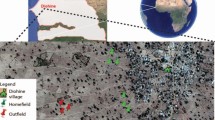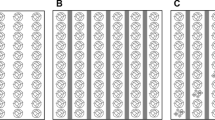Abstract
The paper which covers a two season study from 1981 through 1982, major and minor cropping seasons, describes an improved methodology of sampling for stem-/pod-borer pests within an intercropping farming system involving maize, cowpea and sorghum as target crops. The authors’ approach to the intercropping study has been from a holistic angle in an attempt to gain an understanding of the processes which lead to intercropping advantages under the different cropping patterns. The target pests reported were categorized into three trophic levels: firstly, specialist feeders which were Maruca testulalis (Geyer) on cowpea and Atherigona seccata (Rondani) on sorghum; secondly, the relative specialist feeders as Chilo partelhts (Swinh.), Busseola fusca (Fuller), Eldana saccharina (Wlk.) and Sesamia calamistis (Hmps.) on maize and sorghum; and thirdly the generalist feeders represented by Heliothis armigera (Hbn.) which subsists on cowpea, maize and sorghum plants respectively. The entomological data assayed included levels of borer attack on plant spatial and temporal patterns. The population of C. partellus, the dominant stem-borer within the study area was significantly regulated within the intercropping systems. The borer incidence on the maize and sorghum monocrops and the maize/sorghum dicrop was earlier (>14 days after germination, DAG) and accentuated with time, whereas intercropping of the cereals with non cereals caused significant delay (>42 DAG) in the borer colonisation and establishment within the intercropping systems. Incidence of ‘dead hearts’ caused by the borers was significantly higher (P < 0.05) within sorghum than maize stands; a factor related to the significantly higher borer attacks on late tillers which suggest that plant ventrical heights within stands influenced borer attacks. Sorghum shootfly was restricted to within 42 DAG and very much regulated by intercropping. Maruca testulalis attack on cowpea plants was confined between 30 through 60 DAG of cowpeas. Presence or absence of non-preferred cereal hosts within the cropping patterns did not seem to interfere with the M. testulalis colonisation and establishment processes within the cropping patterns. Pod damages resulting from Maruca attack were however influenced by the cropping patterns with mixed maize-cowpea-sorghum intercrop, producing significantly higher healthier pods. The paper concludes that some intercropping patterns have many advantages over monocropping patterns with respect to pest colonisation and establishment.
Similar content being viewed by others
References
Altieri M. A., Francis C. A., Van Schoonhoven A. and Doll J. D. (1978) A review of insect prevalence in maize (Zea Mays L.) and bean (Phaseolus vulgaris L.) polycultural systems. Field Crop Res. 1, 33–49.
Anon (1978) Farming Systems Research at the International Agricultural Research Centres. World Bank, Washington D.C. 66 pp.
Anon (1981) Pest Control in Tropical Grain Legumes. C.O.P.R. London, 206 pp.
Atkins C. A. (1982) Nitrogen fixation potentials for improvement in legumes. In Induced Mutations for Improvement of Grain legume Production. II. 60, pp. 147–168. IAEA-TECDOC.
Coaker T. H. (1956) An experiment on stem-borer control on maize. E. Afr. Agric. J. 21, 220–221.
Evans A. C. (1960) Studies on intercropping: I. Maize and sorghum with groundnuts. E. Afr. Agric. Fo. J. 26, 1–10.
Haizel K. A. (1974) The agronomic significance of mixed cropping. I. Maize interplanted with cowpea. Ghana Inl. Agric. Sci. 7, 169–178.
Hill D. S. (1975) Agricultural Insect Pests of the Tropics and their Control. Cambridge University Press. London, 516 pp.
Huffaker C. B. (1962) Some concepts on the ecological basis of biological control of weeds. Can. Ent. 94, 507–514.
Ingram W. R. (1958) The lepidopterous stalk-borers associated with Gramineae in Uganda. Bull. ent. Res. 49, 367–383.
Janzen D. H. (1973) Tropical agroecosystems. Science 182, 1212–1219.
Johnson C. J. (1969) Migration and Dispersal of Insects by Flight. Methuen, London.
Kramer C. Y. (1956) Extension of multiple range tests to group means with unequal numbers of replications. Biometrics 12, 307–310.
Norman D. W. (1974) Rationalising mixed cropping under indigenous conditions. The example of Northern Nigeria. J. Dev. Stud. 11, 3–21.
Nye I. W. B. (1960) The insect pests of graminaceous crops in East Africa. Colon. Res. Stud. No. 31, H.M.S.O., London. 48 pp.
Odum E. P. (1977) The emergence of ecology as a new intergrative discipline. Science 195, 1289–1293.
Perrin R. M. (1977) Pest management in multiple cropping systems. Agroecosystems 3, 93–118.
Perrin R. M. and Phillips M. L. (1978) Some effects of mixed cropping on the population dynamics of insect pests. Ent. expt. Appl. 24, 385–393.
Pimentel D. (1961) The influence of plant spatial patterns on insect populations. Ann. ent. Soc. Am. 54, 61–69.
Risch S. (1980) The population dynamics of several herbivorous beetles in tropical agroecosystem: the effect of intercropping corn, beans, and squash in Costa Rica. J. Appl. Ecol. 17, 593–612.
Ruthenberg H. (1976) Fanning Systems in the Tropics. (1st edition) Clarendon Press, Oxford.
Singh S. R., Taylor T. A. and Van Emden H. F. (1978) Pests of Grain Legumes: Ecology and Control. Academic Press, London, 454 pp.
Smith J. G. (1976) Influence of crop background on aphids and other phytophagous insects on Brussels sprouts. Ann. Appl. Biol. 83, 1.
Southwood T. R. E. and Way M. J. (1970) Ecological background to pest management. In Concepts of Pest Management (Edited by Rabb R. L. and Guthrie F. E.), pp. 6–28. N.C. State Univ., Raleigh.
Tahvanainen J. O. and Root R. B. (1972) The influence of vegetational diversity on the population ecology of a specialized herbivore, Phyllotsela crucifera (Colcoptera: Chrysomelidae) Oeeologia 10, 312–346.
Taylor T. A. (1978) Maruca testulalis: An important pest of tropical grain legumes. In Pests of Grain Legumes: Ecology and Control. (Edited by Singh S. R., Taylor T. A. and Van Emden H. F.) pp. 193–200. Academic Press, London.
Wilhelm S. (1976) The agroecosystem: a simplified plant community. In Integrated Pest Management. (Edited by Apple J. L. and Smith R. F.) pp. 59–70. Plenum Press, New York.
Wiley R. W. and Osiru D. S. O. (1972) Studies on mixtures London. of maize and beans (Phaseolus vutgaris) with particular reference to plant population. J. Agric. Sci. 79, 517–529.
Wit C. T. de (1960) On competition. Verse. Lundbouwk. Onderz. Wageningen N.R. 688.
Author information
Authors and Affiliations
Rights and permissions
About this article
Cite this article
Amoako-Atta, B., Omolo, E.O. & Kidega, E.K. Influence of Maize, Cowpea and Sorghum Intercropping Systems on Stem-/Pod-Borer Infestations. Int J Trop Insect Sci 4, 47–57 (1983). https://doi.org/10.1017/S1742758400004021
Received:
Published:
Issue Date:
DOI: https://doi.org/10.1017/S1742758400004021




